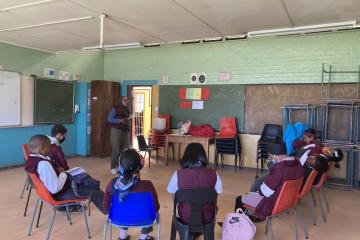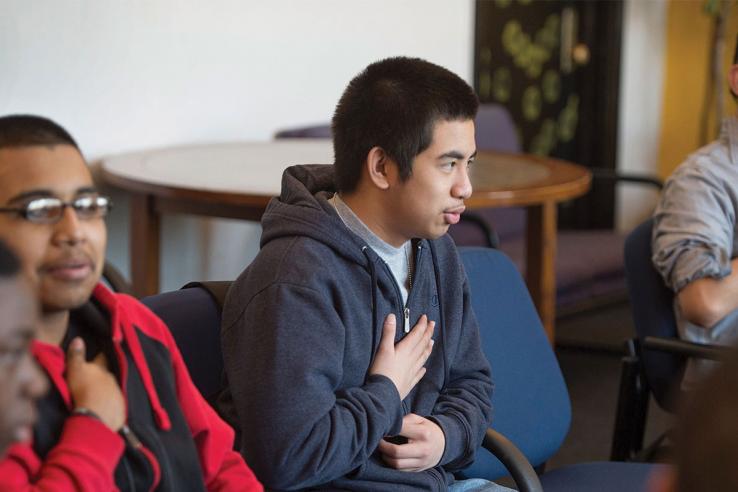
Preventing crime and violence with behavior change techniques

Summary
A growing number of crime and violence prevention programs have sought to draw on psychosocial techniques as a means of shifting the way people think and make decisions. These behavior change techniques often aim to address peoples’ cognitive biases as a way to help them to improve their decision-making and self-regulation skills.
One psychological approach that many such interventions draw from is cognitive behavioral therapy (CBT).1 CBT is just one of multiple approaches that teaches people to evaluate and modify the way they think and make decisions. A key aspect of CBT helps participants recognize how cognitive biases, such as making default assumptions, can distort decision-making. Further behavioral techniques can then be used to help individuals think more systematically about the situations they are in, slow their decision-making, plan ahead, and set goals, all of which can help curb violent and self-destructive tendencies. These techniques also often aim to help participants improve their self-image, adopt identities that are associated with less violent norms of behavior, and relate and adapt to their environments, which can further promote behavioral change that reduces crime and violence.
Evidence from eight experimental and quasi-experimental evaluations of behavioral interventions designed to change how people think about themselves or their situations suggests these programs have been effective in reducing criminal, violent, and antisocial behaviors across a range of contexts and populations. There is still some debate regarding the precise mechanisms driving changes in participant behaviors. However, where studies have been able to isolate and test for mechanisms, evidence suggests that these interventions may help participants reduce automatic thinking, slow down their decision-making processes,[7] improve their emotional regulation,[5] and/or consider alternative perspectives.[6] Moreover, the majority of the programs tested involved low-cost interventions with simple, standardized curricula, most often delivered by facilitators with no formal training in social work or psychology. This suggests that behavior change programs are promising as a cost-effective, adaptable approach to reduce crime and violence.
Supporting evidence
In high-crime and high-violence settings, implementing interventions inspired by CBT principles reduced participation in crime and antisocial activities.
In seven evaluations, programs that drew on CBT principles reduced a range of criminal, violent, and antisocial behaviors.[1][2][3][4][5][7] In high-crime neighborhoods in Monrovia, Liberia, an eight-week curriculum that combined CBT-informed group therapy and one-on-one counseling led to persistent decreases in participants’ criminal and violent behavior—particularly, in the short run, when combined with a US$200 cash transfer.[3] After 10 years, researchers observed a 0.2 standard deviation decline in antisocial behaviors among men who received therapy alone and a 0.25 standard deviation decrease among those who received therapy and cash. These findings suggest that over a 10-year period, those who received therapy plus cash committed 200 fewer crimes relative to those in the comparison group.[4]
In Chicago, staff from the Cook County Juvenile Temporary Detention Center (JTDC) delivered twice daily CBT sessions over roughly three to four weeks for male youth who, on average, had been arrested eight times in the past. The program led to persistent reductions in readmission rates after release—participants were 39 percent less likely to be readmitted within 2 months of release and 21 percent less likely to be readmitted 18 months later.[7] A second quasi-experimental evaluation of a similar intervention implemented in provincial jails in Quebec found that the program reduced the likelihood of recidivism by 18 percentage points (60 percent) one year following release, though the program did not appear to impact prison misconduct or the likelihood of being granted parole.[1]
Based in part on findings from previous studies of CBT-based interventions in Liberia and Chicago, a team of implementers and researchers designed the Rapid Employment and Development Initiative (READI). This initiative provided a combination of subsidized employment opportunities with professional development sessions and group-based CBT to men at highest risk of being involved in gun violence in Chicago over an 18-month period. While the intervention had no detectable impact on a combined measure of serious violence, there is suggestive evidence that READI reduced arrests for shooting and homicides. Moreover, participants who were referred to participate in the program by outreach workers saw a 0.13 standard deviation reduction in involvement in serious violence, driven by a 79 percent reduction in arrests for shooting and homicides and a 43 percent reduction in victimizations for the same types of crime.[2]
In some cases, these behavior change interventions demonstrated the strongest impacts among the most antisocial participants, suggesting that targeting is essential.
In Liberia, the reductions in crime and violence were greatest among the men who reported the highest levels of antisocial behavior before starting the program. For this group, therapy alone reduced antisocial behavior by 0.91 standard deviations and therapy and cash by 1.25 standard deviations.[4]
Moreover, the READI program highlights how a highly targeted intervention—involving less than 0.01 percent of Chicago’s population—can lead to positive impacts on citywide crime and violence reduction. In the absence of the READI program, the roughly 2,500 men who participated in the study would have accounted for about 6 percent of Chicago’s shooting and homicide victims during an average 20-month period. Researchers estimate that the incidents of crime and violence in which they would have been involved would cost society between US$711 million and US$3.6 billion. Of men offered to participate in READI, 55 percent started the program, with higher take-up (78 percent) among outreach referrals, and roughly 75 percent were still participating at the 20-week mark. These findings indicate that this approach was effective in engaging a population that was otherwise generally disconnected and untrusting of many state services and institutions.[2]
When behavioral levers designed to change decision-making of youth were implemented in school settings, they also improved educational outcomes.
In low-income Chicago Public Schools, the NGO Youth Guidance implemented the “Becoming a Man” (BAM) curriculum, which engaged male students in grades 7–10 in weekly hour-long group sessions that incorporated a range of experiential, reflective, role-playing, and skills-building exercises grounded in CBT principles over a period of one to two school years. Not only did total arrests during the program decline by 28–35 percent, but graduation rates also increased by 12–19 percent. However, effects on arrests did not persist beyond the program period. BAM helped students learn strategies to relate to their environments, slow down their decision-making processes, and plan ahead. For example, in a game designed to test decision-making, students in the program took about 80 percent more time than those in the comparison group to decide how to respond to a peer in a money transaction scenario.[7]
Similarly, in El Salvador, NGO Glasswing implemented an after-school program that combined group-based discussions of socioemotional skills, conflict management, and violence awareness together with club activities. The program decreased both students’ self-reported delinquent and violent behaviors and teachers’ assessments of bad behaviors in the classroom. In addition, students eligible to participate in the program recorded 1.6 fewer days absent per month, and their math and science grades increased by 0.11 and 0.13 standard deviations, respectively. Notably, students with higher baseline levels of misbehavior experienced greater reductions in absenteeism, consistent with the targeting takeaway above. Through additional assessments, the researchers also observed positive effects of the program on participants’ emotional self-regulation, suggesting students who participated in the program could react more calmly when facing both positive and negative external stimuli.[5]
In one study in the policing domain, behavioral tools designed to change the thinking of police officers were also found to reduce violent outcomes.
One such training, Situational Decision-Making (or Sit-D), implemented with police officers at the Chicago Police Department, trained officers to think more systematically in ambiguous, high-stress situations. The training, which drew on findings from a broad behavioral science literature on techniques for mitigating cognitive biases in decision-making, was delivered through four four-hour sessions.2 The evaluation of Sit-D found that trained officers reduced both their use of nonlethal force and discretionary arrests (i.e., low-level arrests with little public safety value) by 23 percent. The program also reduced arrests of Black civilians by 11 percent, without lowering the arrest rates of other civilians, suggesting that it reduced racial disparities in policing despite this not being an explicit focus of the program.
This study also tested a specific mechanism behind these observed effects. Sit-D focused on training officers to improve deliberation by rapidly considering alternative interpretations of ambiguous situations. Findings from a series of lab assessments indicate that trained officers were able to come up with more varied explanations of subject behavior and updated their assessments of situations as they changed, suggesting they relied less on default assumptions and were better able to fully consider different potential interpretations of the situations they encountered.[6]
Behavior change interventions may offer a high-potential, cost-effective alternative to more traditional security sector interventions for crime and violence prevention.
The majority of the interventions described above involved low-cost interventions with relatively simple, standardized curricula most often delivered by facilitators with no formal training in social work or psychology,[1][3][4][5][6][7] suggesting these approaches could be replicated across a variety of contexts. On the lower end, program costs per participant ranged from US$60 at the JTDC,[7] where the program was integrated into the center’s existing infrastructure, to US$530 for a CBT-inspired program in Liberia,[3] US$807 to US$864 for the Sit-D program in Chicago,[6] and between US$1,110 and $1,850 per year for BAM in Chicago Public Schools.[7]
In Chicago, researchers estimate that BAM’s overall societal benefits were anywhere from 5 to 30 times greater than the program’s costs, and the JTDC program reduced recidivism at a cost of US$114 per readmission avoided per year.[8] While the full range of potential societal benefits of the Sit-D program are difficult to measure, researchers estimate that the savings in personnel costs alone, given reductions in officer injuries, outweighed the cost of the training.[6] Outside of the US context, in Quebec, by reducing recidivism, the author estimates that the program saved roughly US$3,800 per inmate in incarceration costs alone.[1] Moreover, in Liberia, estimates suggest that the program resulted in more than 200 fewer crimes committed per participant, implying a cost of less than US$2.50 per crime avoided.[4]
While the READI program was more expensive to implement (at roughly US$52,000 per participant over 20 months), researchers estimate that its benefits were at least 3.5 times (and perhaps up to 18 times) as large as the programs cost, estimating that the program reduced social harms by US$182,000 to US$916,000 per participant.[2] Given the high costs that violent behaviors impose on society, these findings suggest that even expensive programs can be worthwhile investments when targeted appropriately.
J-PAL Policy Insight. 2024. “Preventing Crime and Violence with Behavior Change Techniques.” Cambridge, MA: Abdul Latif Jameel Poverty Action Lab.
We specifically highlight CBT as it has informed, at least in part, the design of all of the interventions described in this insight. Often, these programs also incorporate a variety of other techniques that draw from a broader behavioral science literature.
In addition to drawing on principles from CBT, the training incorporated lessons from a broader behavioral science literature, including on the psychology of judgment and decision-making.
Arbour, William. “Can Recidivism Be Prevented from Behind Bars? Evidence from a Behavioral Program.” Working Paper, October 2022. Research Paper
Bhatt, Monica P., Sara B. Heller, Max Kapustin, Marianne Bertrand, and Christopher Blattman. 2024. “Predicting and Preventing Gun Violence: An Experimental Evaluation of READI Chicago.” Quarterly Journal of Economics 139, no. 1: 1–56. Research Paper
Blattman, Christopher, Julian C. Jamison, and Margaret Sheridan. 2017. “Reducing Crime and Violence: Experimental Evidence from Cognitive Behavioral Therapy in Liberia.” American Economic Review 107, no. 4: 1165–1206. Research Paper | Evaluation Summary
Blattman, Christopher, Sebastian Chaskel, Julian C. Jamison, and Margaret Sheridan. 2023. “Cognitive Behavior Therapy Reduces Crime and Violence over 10 Years: Experimental Evidence.” American Economics Review: Insights 5, no. 4: 527–545. Research Paper | Evaluation Summary
Dinarte-Diaz, Lelys and Pablo Egana-del Sol. 2023. “Preventing Violence in the Most Violent Contexts: Behavioral and Neurophysiological Evidence from El Salvador.” Journal of the European Economic Association (November) Research Paper
Dube, Oeindrila, Sandy Jo MacArthur, and Anuj K. Shah. “A Cognitive View of Policing.” NBER Working Paper #31651, September 2023. Research Paper
Heller, Sarah B., Anuj K. Shah, Jonathan Guryan, Jens Ludwig, Sendhil Mullainathan, and Harold A. Pollack. 2017. “Thinking, Fast and Slow? Some Field Experiments to Reduce Crime and Dropout in Chicago.” Quarterly Journal of Economics 132, no. 1: 1–54. Research Paper | J-PAL Evaluation Summary
Abdul Latif Jameel Poverty Action Lab (J-PAL). 2017. "Practicing Choices, Preventing Crime" J-PAL Policy Briefcase. Last modified October 2017. https://www.povertyactionlab.org/publication/practicing-choices-preventing-crime.
